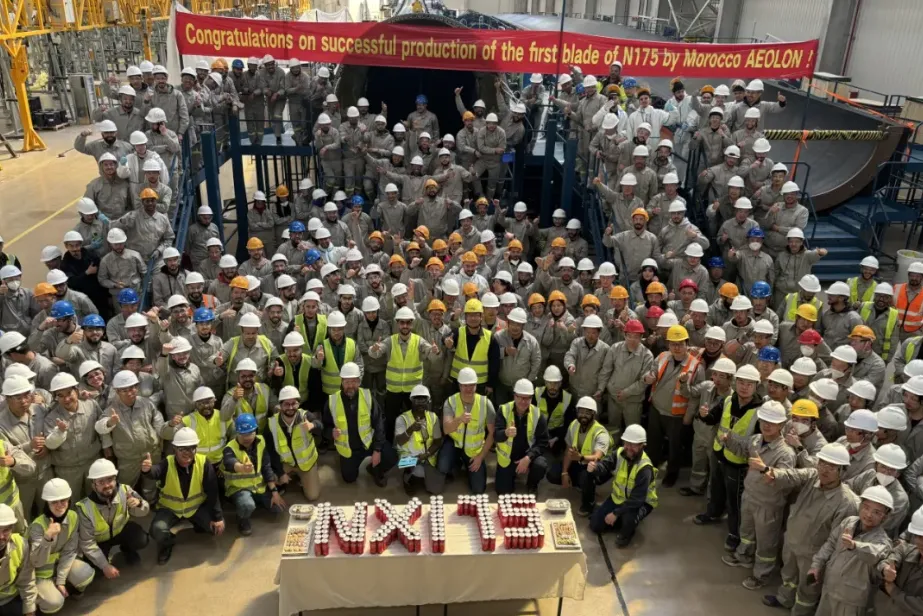New Chinese blade plant eyes Europe from Morocco
New Aeolon factory ideally placed and could export to Africa, Middle East, Europe and even North America, say analysts

A new Chinese wind turbine blade factory is set to fire up production in Morocco with Nordex having seemingly already signed up for exports and analysts predicting “strong interest” from Vestas and Siemens Gamesa.
This is the first overseas factory the Chinese blade maker has opened. Aeolon previously said the facility would cost around 1.75bn RMB ($242m) and boast an annual production capacity of 600 sets of blades.
The factory in the northern port city of Nador, which overlooks Spain across the Alboran Sea, produced its first trial blade back in February.
“This facility can address the demand for blades in markets that we expect Chinese turbine manufacturers to fully dominate, such as Africa and the Middle East, while eying to support European and potentially North American demand.”
The factory is located close to the Port of Nador, which Lico said makes it “ideal for overseas exports.”
However, the port itself is not ready yet, said Lico. The Nador West Med complex, as it is otherwise known, is being built in phases and will ultimately consist of a deep-water port and an integrated industrial port platform in a free trade zone.
Belgian construction giant Jan De Nul, one of the companies working on the port, says that Nador is set to become Morocco’s “next economic hub” due to its ideal location on the caravan route between Europe and Africa.
Lico expects the first shipment of Aeolon blades from the port could be around October this year.
Morocco has been a strategic location for Chinese investment ever since it became the first North African nation to join the country’s Belt and Road Initiative in 2017. “Given Morocco’s position as a link between Europe and Africa, China sees Morocco as a strategic gateway to international markets,” said Lico.
Morocco and the EU established a Free Trade Area in 2000, while the North African country also enjoys a Free Trade Agreement with the US – another potential export destination for Aeolon.
“On top of that, Morocco’s stable economic landscape has proven fertile for foreign investment,” said Lico. “This is due to government support and significant tax-breaks for new energy initiatives and manufacturing, as well as an abundance of cheap skilled labor because of government training programs.”
Andrea Scassola, vice president of wind research at Norwegian consultancy Rystad Energy, said that overseas sales account for a “large proportion” of Aeolon’s revenue.
Setting up shop in Morocco allows Aeolon to move “closer to its main customers, Vestas and Siemens Gamesa” – adding that he would “expect strong interest” from the two European turbine-making giants.
Aeolon has produced V136 and V150 blades for Vestas, whose head of global transport planning, Ignacio Mora, previously posted on LinkedIn that the new Nador factory is a “potential game changer at the gates of Europe.”
Aeolon also boasts close relationships with Germany turbine makers Nordex and Enercon. Indeed, the first trial blade produced at its factory in February is labelled as an “N175” and "NX175" in photos published, with Scassola saying he has confirmed it is for a Nordex N175 machine.
Nordex did not respond to a request for comment but Enercon confirmed Aeolon will produce rotor blades for its new top model E-175 EP5 in China from 2026, supplementing the German company’s own blade hub in Portugal. Whether Aeolon could eventually also supply Enercon from Morocco remains to be seen.
By setting up in Morocco, Scassola said Aeolon and other Chinese suppliers can “gain tariff-free access to EU markets while diversifying production away from China – aligning with the EU’s efforts to reduce reliance on a single source of supply.”
The factory can also help ease supply chain bottlenecks in the European offshore wind industry by adding capacity to meet the growing demand for offshore blades, he said.
Siemens Gamesa opened its own blade factory in Morocco in 2017 in Tangier, not far from Nador on Morocco’s northern coast. However, just five years later, the German-owned OEM decided to shut up shop there, citing the supply chain crisis in the global wind industry.